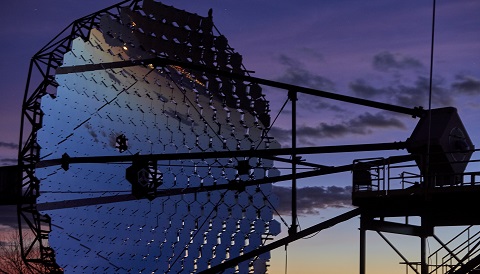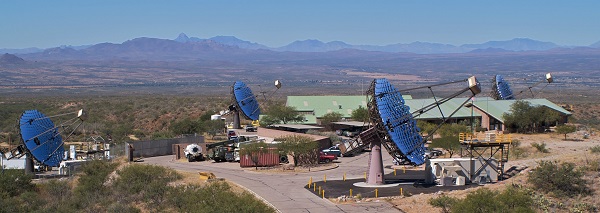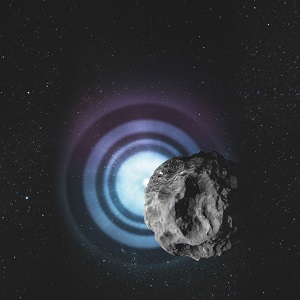Astronomers have used a unique method and an extraordinary telescope array to reveal the diameters of distant stars.

NSF / VERITAS
It's amazing how much information you can coax out of a few photons. For decades, astronomers have watched asteroids as they blocked out stars behind them — these occultations revealed the asteroids' shape and size as their "shadows" swept across Earth. Now, astronomers are using asteroid occultations to reveal the sizes of the stars themselves.
Astronomers used the Very Energetic Radiation Imaging Telescope Array System (VERITAS), located at the Fred Lawrence Whipple Observatory in Arizona, to do just that, publishing the results in Nature Astronomy. VERITAS is a group of four 12-meter telescopes, each composed of 350 hexagonal mirror segments. They're set up to watch for the faint blue flashes of Cherenkov radiation, produced when energetic charged particles crash into Earth's atmosphere. But Wystan Benbow (Center for Astrophysics, Harvard & Smithsonian) and colleagues turned the telescopes toward asteroid shadows.
First, the asteroid 1165 Imprinetta passed in front of a star designated TYC 5517-227-1. In this proof-of-principle observation, the astronomers used VERITAS to snap 300 images a second, pegging the star at 11 times the Sun's width. Then a few months later, 201 Penelope passed in front of another star, TYC 278-748-1. This time VERITAS captured 2,500 images every second as the shadow passed over Earth, allowing it to measure an even smaller star only twice the Sun's diameter.

NSF / VERITAS
Although the mirrors of the VERITAS array are crude by astronomical standards, it was the telescopes' incredible time resolution that made it possible to measure the stars' diameters. “VERITAS telescopes are very large, and that is very important for taking accurate measurements with very fast sampling frequencies,” says Tarek Hassan (DESY, Germany). Large detectors like the VERITAS telescopes also don't see as much scintillation noise, the "twinkling" caused by turbulent motions in Earth's atmosphere.

DESY/Lucid Berlin
To measure an occulted star's size, the astronomers first need to capture the delicate "fringes" of the diffraction pattern along the edge of the shadow it casts. These fringes are where light waves merge to alternately boost or cancel the signal. (In fact, every shadow has diffraction fringes at its edges, but for the objects we interact with on a daily basis at visible wavelengths, these fringes are imperceptible.)
When an asteroid passes in front of a star, the asteroid itself is invisible, but an observer will see the star it's blocking briefly wink out. Thanks to diffraction fringes along the asteroid shadow's edge, the star's brightness will vary in a predictable way right before and after shadow sweeps across Earth. By comparing the fringes around an occulted star to those from a true point source, the astronomers infer the diameter of the star.
The Asteroids & The Stars
The 60-km-wide asteroid Imprinetta passed in front of the first star, the 10.2-magnitude red giant TYC 5517-227-1 in the constellation Crater, the Cup, on February 22, 2018. Observations revealed the star to be have an apparent size of 0.125 milliarcseconds. (For reference, that's more than 1,000 times better than what the Hubble Space Telescope can resolve.) Given the star's distance of 2,674 light-years, its tiny angular size equates to a girth 11 times that of the Sun. It's the most distant star to date with an accurate measurement of its angular size.

Benbow et al
A second chance for the team came on May 22, 2018, when the 88-km asteroid Penelope swept in front of the 9.9-magnitude star TYC 278-748-1 in the constellation Virgo. Occultation measurements revealed that the star, at 700 light-years away, had a diameter just over twice the Sun's.
Catching Occultations
Occultations are not easy to predict or observe. The first attempted observation of an asteroid occultation was on February 19, 1958, when 3 Juno was predicted to pass in front of a star. Observations of this event, however, later proved to be a false positive. The first successful capture of a stellar asteroid occultation was by asteroid 2 Pallas on October 2nd, 1961. Only a handful of such events were observed up until the 1980s. Today, Steve Preston's site lists dozens of such events occurring worldwide, every month.
“The [occultation] technique itself is not really new,” Hassan notes. “What's new is that now we have better knowledge of the location and speed of many solar system objects so far away... and thanks to Gaia and other missions we have unprecedented knowledge of the stars' exact location on the sky.”
Astronomers have also used a diffraction method during lunar occultations, but it only works for stellar diameters down to about 1 milliarcsecond. Only 17 stars have a resolved angular diameter greater than this, and of those, only Antares lies along the current path of the Moon. Occultations of Antares are quick, as we witnessed from our backyard in Florida in 2009:
Because asteroids are much farther from Earth than the Moon, astronomers can use them to measure much smaller stars, explains Daniel. “This is why our asteroid occultation measurements were able to measure the smallest angular size stars thus far measured.”
Even so, using occultations to measure star sizes remains a chancy business because of the uncertainty in asteroid orbits, and if the predicted path changes, tough luck, because large telescopes aren't terribly portable. The shadow of asteroid Imprinetta, for example, had a 50% chance of crossing over the VERITAS array, and Penelope's shadow had an even lower chance of 29%. Nevertheless, the researchers figure, any telescope capable of observing a 10th-magnitude star would see about five occultations per year.
This method could also be applied using the next generation of megatelescopes: The Giant Magellan Telescope, for example, could reach to far fainter stars, and the Large Synoptic Survey Telescope would capture fast images. Both telescopes are set to see first light early in the coming decade.
 11
11









Comments
Rod
April 24, 2019 at 10:01 am
Very good report. I enjoyed the 1:57 minute video on Moon occulting Antares in 2009. Here is a note from my stargazing log for that event (06-June-2009) that I observed in Maryland: "Saturday evening 2200-2245 EDT (0200Z – 0245Z, 06/07/09). According to USNO web site, Full Moon is 1412 06/07/09. Sunset tonight was 2030 EDT and end of civil twilight 2101 EDT. I enjoyed viewing the lunar occultation of Antares in Scorpius tonight. Sky & Telescope predicted 2237 EDT for disappearance of Antares behind lunar limb (Washington D.C.), my watch showed 2238 EDT. I used 40-mm with 2.5x barlow and my lunar filter. As I watched the gap close between the lunar limb and Antares, suddenly the red supergiant disappeared behind the lunar limb. Earlier I could see the Moon and Antares using my 10x50 binoculars..."
You must be logged in to post a comment.
Lou
April 25, 2019 at 8:28 am
Fantastic! Who'd have thought VERITAS would be used to measure diameters of stars! I do think the 1,000 x better resolving power is a little mean on ol' Hubble. It can resolve down to 50 milliarcsecs in the UV with dithering, and it also hosts an interferometer (FGS) that can achieve 0.2 milliarcsecs - almost as good as this experiment (granted, that's during multi-epoch astrometry - I imagine it's somewhat coarser in scan mode, but FGS has measured diameters of stars).
You must be logged in to post a comment.
Thomas Haas
April 27, 2019 at 6:44 am
Eh what ? Cerenkov radiation is caused by gamma rays ? I think you have it the wrong way round !
Cerenkov RADIATION is caused by charged PARTICLES.
You must be logged in to post a comment.
fif52
April 27, 2019 at 8:03 pm
A new way of measuring a diameter, rule of law. Could a stop watch surffice, 55 seconds=11x. This is actually a good idea but how far away was the asteroids or doesn't it matter?
You must be logged in to post a comment.
David DickinsonPost Author
April 28, 2019 at 9:51 am
My first thought: a milliarcsecond is so tiny, the reaction time error using a stopwatch would be much longer (on the order of tenths of a second) than the event itself.
You must be logged in to post a comment.
fif52
April 28, 2019 at 7:00 pm
2674
TYC 5517-227-1 at 2674ly with astroid 60km wide is 8.01 millarcseconds wide.
Right ascension
20h 50m 00"
Declination
+12 48' 43.2"
TYC 278-748-1 at 700ly with astroid 88km wide is 10.63 millarcseconds wide.
Right ascension
20h 46m 47.9"
Declination
+5 45' 29.52"
You must be logged in to post a comment.
David DickinsonPost Author
April 29, 2019 at 10:14 am
Thanks... the diameters for the two stars measured in the study were 0.125 milliarcseconds (TYC 5517-227-1) and 0.9 milliarcseconds (TYC 278--748-1). see the graphs on Page 6: https://arxiv.org/pdf/1904.06324.pdf
You must be logged in to post a comment.
Numerics
April 30, 2019 at 2:29 am
With the very accurate orbital motion of artificial satellites, can we not do a better job using them instead of asteroids?
You must be logged in to post a comment.
Peter Wilson
April 30, 2019 at 11:34 am
For artificial satellites, moving so much faster than distant asteroids, the satellite's fringes would come-and-go ultra fast. Notice that the time-scales for the intensity graphs are in milliseconds. For artificial satellites, you would need detectors with picosecond resolution. Not practical at present.
You must be logged in to post a comment.
David DickinsonPost Author
April 30, 2019 at 12:20 pm
Thanks, that was my first thought as well. Satellites are much closer, and maybe we know their position with a greater degree of precision... but they're also moving ultra-fast across the sky compared to asteroids, as well.
You must be logged in to post a comment.
fif52
April 30, 2019 at 5:55 pm
TYC 5517-227-1 being occulted by asteroid 1165 Imprinetta is 60km across, +12.812° and 2.4589au away moves at 0° 10' 42.6"/day, equates to 12.94km/s and 1millarcsecond equates to 1.8km, so occulted in 4.63 seconds.
You must be logged in to post a comment.
You must be logged in to post a comment.